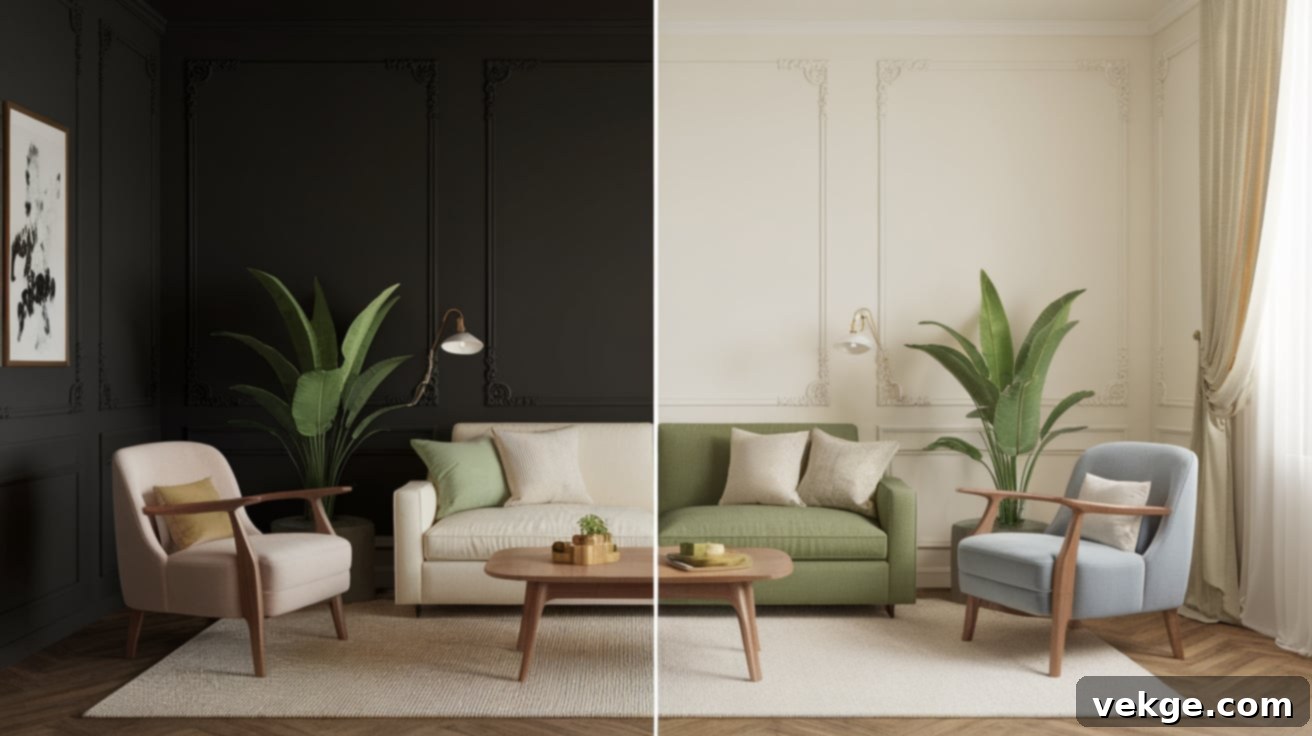Transform Your Home: The Ultimate Guide to Brightening Any Room with Paint
Do your rooms feel perpetually dim, even on the sunniest days? You’re not alone. It’s incredibly frustrating when your living spaces feel small and gloomy, rather than open, airy, and inviting. The good news is, you don’t need a major renovation to achieve a brighter home. Often, the solution is as simple as a fresh coat of paint – but choosing the *right* color is key.
This comprehensive guide will show you exactly how to select paint colors that will instantly make your rooms feel bigger, brighter, and more welcoming. We’ll explore the science behind light and color, walk you through practical considerations, and equip you with expert tips to avoid costly mistakes you might regret later. Get ready to transform your living spaces without the headache!
Color Theory Behind Brightening Your Space with Paints
Understanding the fundamental principles of color theory is your secret weapon for making smart paint choices. It’s not just about picking a light color; it’s about understanding how different shades interact with light and influence perception. As a seasoned expert, I’ve seen firsthand how a little knowledge of color science can dramatically brighten a room.
The most crucial principle to remember is that light colors reflect light, while dark shades absorb it. This simple fact forms the cornerstone of brightening any space with paint.
Here are the key aspects of color theory to consider when aiming for a brighter room:
- Light Shades for Maximum Reflection: Colors like crisp white, soft off-white, pale cream, and gentle yellow are highly reflective. They can bounce back up to 80% of the light that hits them, effectively multiplying the natural and artificial light sources in your room. This visual trick makes walls appear to recede, expanding the perceived size of the space.
- Cool Tones for an Open Feel: Shades such as light blue, gentle green, and cool grays create a sense of vastness and openness. These colors often evoke feelings of calm and serenity, reminiscent of the sky or ocean. Their subtle coolness helps to push walls visually farther apart, making rooms feel more expansive and less enclosed.
- Warm Whites and Ivory for a Soft Glow: If stark white feels too sterile, warm whites or ivory shades offer a beautiful alternative. These colors have subtle undertones of yellow, pink, or beige that introduce warmth and coziness without sacrificing brightness. They create a soft, inviting glow that mimics natural sunlight, making the room feel cheerfully lit without any harsh glare.
When applying color theory, always consider how natural light changes throughout the day. Morning sun, which tends to be cooler and bluer, might bring out different aspects of a color compared to the warmer, golden light of the afternoon. Testing paint samples at various hours is essential to see how your chosen colors truly behave under different lighting conditions. This careful observation will prevent surprises and ensure your room feels consistently bright and welcoming.
Key Considerations When Selecting Paint Colors
Choosing the perfect paint color isn’t just about personal preference; it involves a careful assessment of several factors unique to your space. Over the years, I’ve helped countless individuals navigate these choices, and I can tell you that overlooking these key considerations can make or break your entire paint project.
Light Sources in Your Room
The amount and direction of natural sunlight in a room are paramount. This changes how colors appear throughout the day. A color that looks vibrant in direct sunlight might appear muted in a dimly lit corner. Pay close attention to:
- Window Direction: South-facing rooms receive bright, warm light all day, allowing you more flexibility with color choices. North-facing rooms, however, get cooler, less intense light and often benefit most from lighter, warmer shades to counteract the coolness. East-facing rooms get bright morning light, while west-facing rooms are bathed in warm afternoon sun.
- Artificial Lighting: Consider your light bulbs. Incandescent bulbs cast a warm, yellowish glow, while LEDs can range from very warm to very cool. The type of artificial light will significantly impact how your paint color is perceived after sunset.
Room Size and Shape
The physical dimensions of your room play a crucial role in color selection. Paint can be a powerful illusionist:
- Small Rooms: Almost always benefit from light colors. These shades reflect more light, making the walls appear to recede and creating an illusion of greater space. Avoid dark, heavy colors, which can make a small room feel claustrophobic.
- High Ceilings: While light walls are great, high ceilings can sometimes feel imposing. Using a slightly warmer or even a very light, subtle contrasting shade on the ceiling can bring it down visually, creating a cozier yet still bright atmosphere.
- Narrow Hallways: Use very light, reflective colors on the walls to make them feel wider and more inviting, rather than long and tunnel-like.
Current Room Design and Furnishings
Your existing furniture, flooring, window treatments, and fixtures are not just background elements; they are integral parts of your color palette. The goal is to choose a paint color that harmonizes with these elements, making them pop rather than clash.
- Undertones: Look at the undertones in your wooden floors, upholstery, and artwork. Do they lean warm (yellow, red) or cool (blue, gray)? Your paint color should ideally complement these existing undertones to create a cohesive and sophisticated look.
- Dominant Colors: If you have a large rug or a prominent piece of art, consider pulling a lighter, complementary shade from it for your wall color. This creates a sense of flow and intentional design.
Testing Environment is Crucial
Never rely solely on tiny paint chips or what a color looks like in a store. Store lighting is vastly different from your home’s natural and artificial light. I always advise my clients to follow this testing process:
- Large Swatches: Paint large patches (at least 2’x2′) on at least two different walls in your room. Ensure one patch is near a window and another on an interior wall.
- Observe Throughout the Day: Live with these samples for a full 24-48 hours. Watch how the colors change in morning light, afternoon sun, and under artificial evening light. This is the only way to truly understand how the paint will behave in your specific environment.
Personal Style and Room Purpose
Ultimately, the paint color should reflect your personal taste and suit the room’s function. A home office might benefit from stimulating yet bright colors, while a bedroom calls for something more soothing and serene.
- Mood and Comfort: Choose shades that evoke the desired mood and make you feel comfortable and happy daily. Even if a color is “perfect” for brightening, if you don’t love it, it’s not the right choice for you.
- Functionality: Consider the practical aspects. A high-traffic hallway might need a more durable finish, while a quiet reading nook can handle a more delicate one.
What Paint Finishes Work Best for Brightening a Room?
Beyond the color itself, the paint’s finish plays a significant role in how much light a room reflects and how bright it ultimately feels. Different finishes offer varying degrees of sheen, which directly impacts their light-reflecting properties. Choosing the right finish can amplify your efforts to brighten a space, while the wrong one can counteract them. Let’s explore the common paint finishes and their brightening potential.
| Paint Finish | Sheen Level | Description | Best Uses | Advantages | Considerations |
|---|---|---|---|---|---|
| High-Gloss | Very High | Highly reflective, mirror-like surface. | Trims, moldings, doors, accent walls (for dramatic effect). | – Maximizes light reflection, creating a vibrant, luminous effect. – Exceptionally durable and easy to clean, resisting moisture and stains. |
– Highlights every imperfection on the surface; requires perfectly smooth walls. – Can be too intense or “shiny” for entire walls in large rooms. |
| Semi-Gloss | High | Slightly less reflective than high-gloss but still shiny. | Bathrooms, kitchens, laundry rooms, accent walls, trim. | – Enhances brightness significantly without being overly reflective. – Highly moisture and stain resistant, making it ideal for wet or high-traffic areas. – Easy to clean and maintain. |
– Can still highlight minor imperfections. – May appear too shiny for living room walls for some preferences. |
| Satin | Moderate | Soft, smooth sheen with moderate light reflection, resembling an eggshell. | Living rooms, bedrooms, hallways, dining rooms, family rooms. | – Offers balanced light reflection, providing a gentle glow. – Durable and relatively easy to maintain and clean. – Versatile and popular for its subtle elegance. |
– Requires careful application to avoid lap marks or roller lines. – Slightly less forgiving than eggshell for surface imperfections. |
| Eggshell | Low | Low-luster finish with minimal sheen, like an eggshell. | Walls in most rooms, especially those with decent natural light. | – Provides subtle light reflection, adding a soft luminosity. – Excellent at hiding minor imperfections better than glossier finishes. – Offers good durability for general living areas. |
– Less reflective than satin or semi-gloss; not ideal for very dark rooms needing maximum light bounce. – Can be harder to clean than shinier finishes. |
| Matte (Flat) | Very Low | Absorbs light, creating a velvety, non-reflective surface. | Ceilings, walls with significant imperfections, formal living rooms, home theaters. | – Hides surface flaws and bumps most effectively. – Creates a sophisticated, cozy, and soft ambiance. – Offers deep, rich color appearance. |
– Does not brighten a room; it absorbs light. – Less durable and harder to clean; susceptible to scuffs and marks. – Not recommended for high-traffic areas or spaces needing brightness. |
When selecting a finish, consider the room’s purpose, expected traffic, and the current condition of your walls. For maximum brightness, lean towards eggshell or satin on walls, and semi-gloss or high-gloss for trim and doors. If your walls aren’t perfectly smooth, eggshell offers a great balance of subtle sheen and flaw-forgiveness.
Top Color Families for Brightening the Rooms
Selecting the perfect paint color is the single most impactful step you can take to brighten a room. The right shade can enhance natural light, visually expand your space, and elevate the overall mood. Based on extensive experience and observation, these color families consistently deliver outstanding results for creating bright, airy, and inviting environments.
Whites
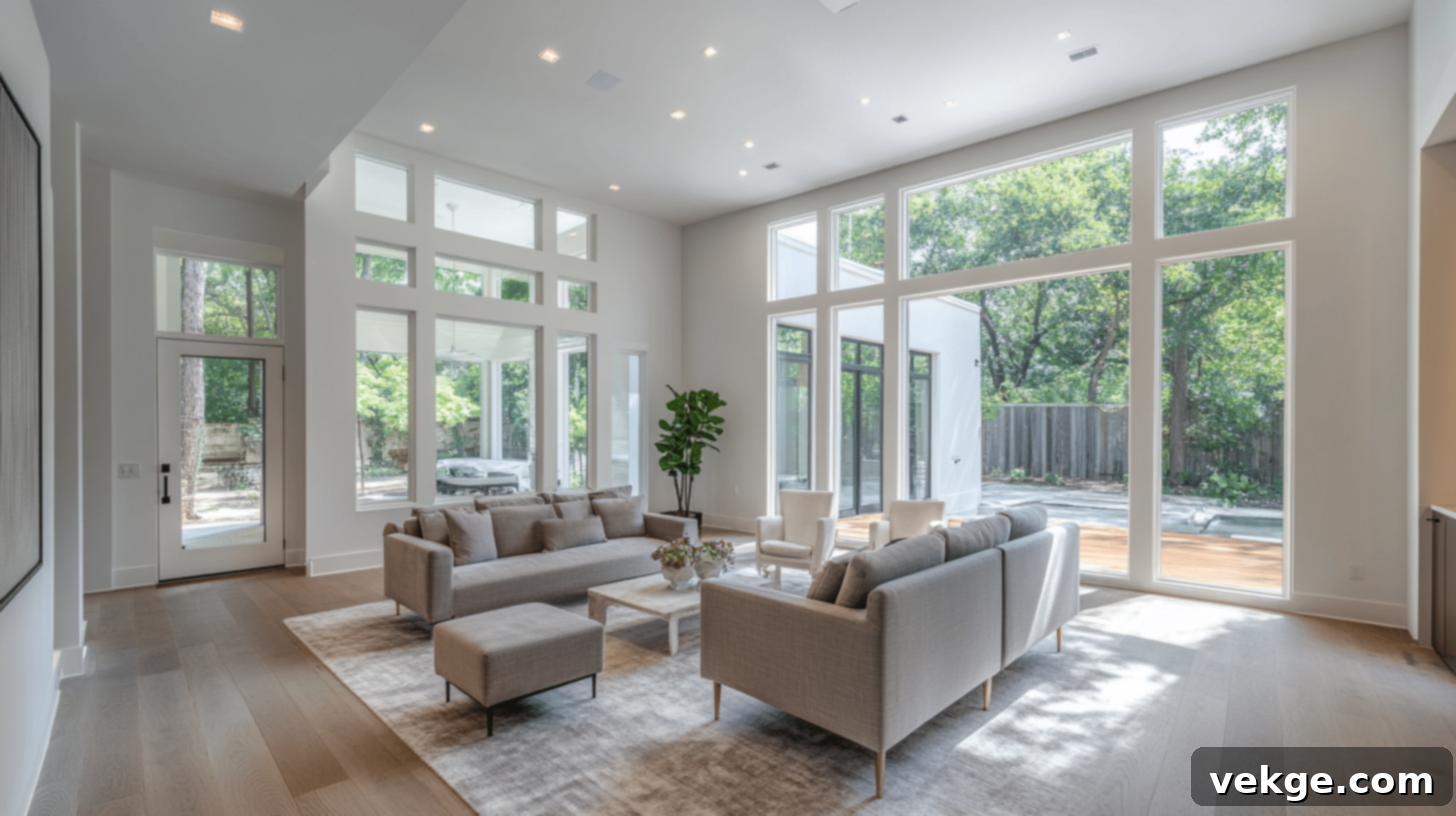
Description: Whites are the ultimate light reflectors, offering clean, pure shades that create an unparalleled sense of openness, freshness, and expansive brightness. They act as a blank canvas, making any room feel instantly larger and more luminous.
My Top Recommendation: Sherwin Williams High Reflective White (SW 7757).
Why It Brightens a Room: This particular white boasts one of the highest Light Reflectance Values (LRV) on the market, meaning it reflects an incredible amount of light. It visually pushes walls back, making spaces feel significantly larger and more airy, while providing a crisp, clean backdrop for any decor style.
Best Uses: Ideal for ceilings, walls, trim, and doors in any room, especially those that lack natural light. It’s perfect for creating a gallery-like feel or a minimalist aesthetic. Great for modern homes, small apartments, and bathrooms.
Warm Neutrals
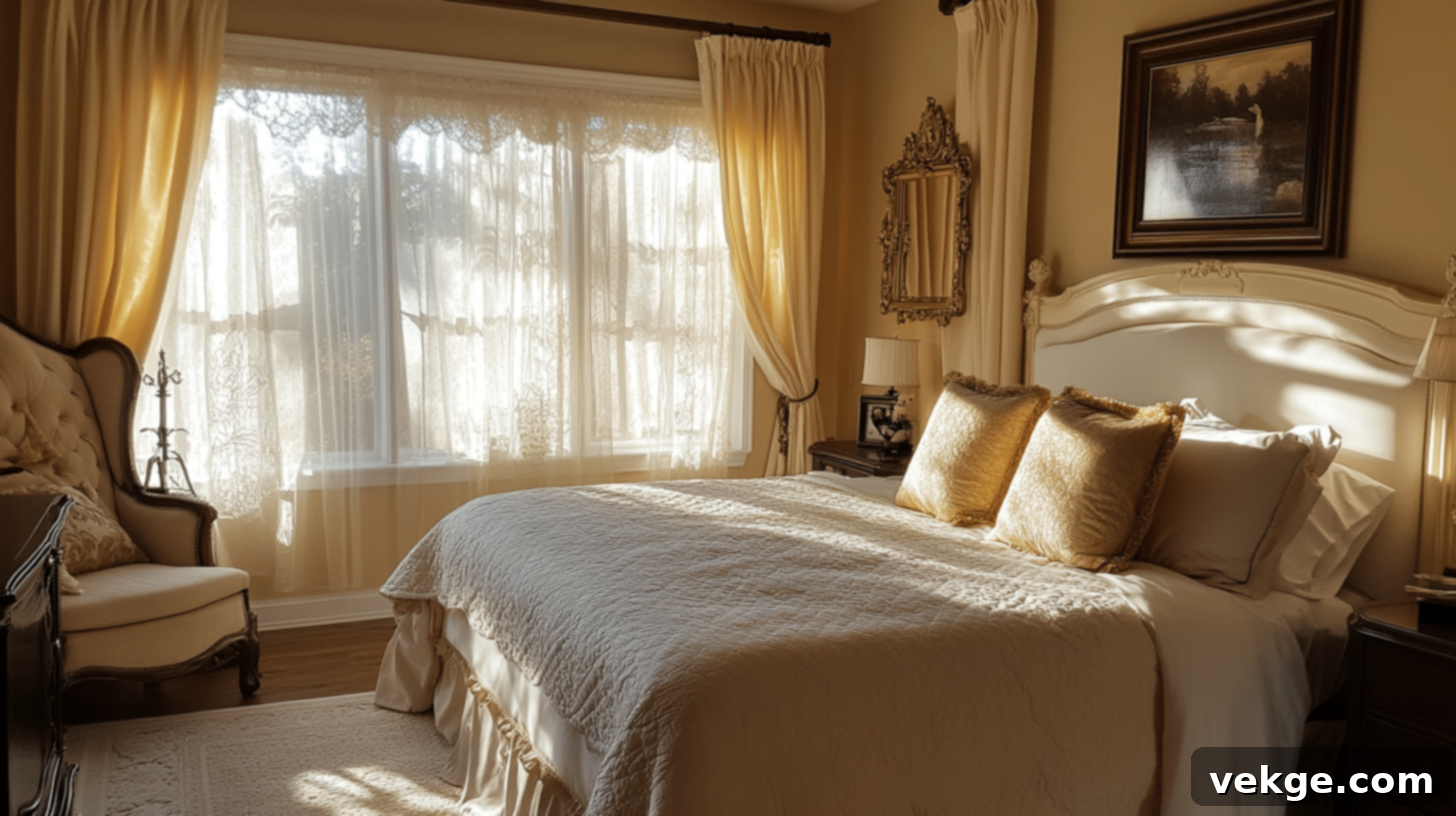
Description: Warm neutrals encompass soft beiges, gentle greiges, and subtle taupes. These shades add a layer of warmth and sophistication without ever making a room feel dull or heavy. They provide a comforting embrace while maintaining a bright and inviting atmosphere.
My Top Recommendation: Sherwin Williams Eider White (SW 7014).
Why It Brightens a Room: Eider White is a soft, warm off-white that carries just enough gray and beige undertones to provide character and warmth without sacrificing brightness. It reflects substantial light, creating an inviting, cozy atmosphere that still feels wonderfully bright and spacious, especially in cooler light.
Best Uses: Excellent for living rooms, bedrooms, and open-concept spaces where you desire a cozy yet bright and elegant feel. It pairs beautifully with natural wood tones and a variety of accent colors.
Light Grays
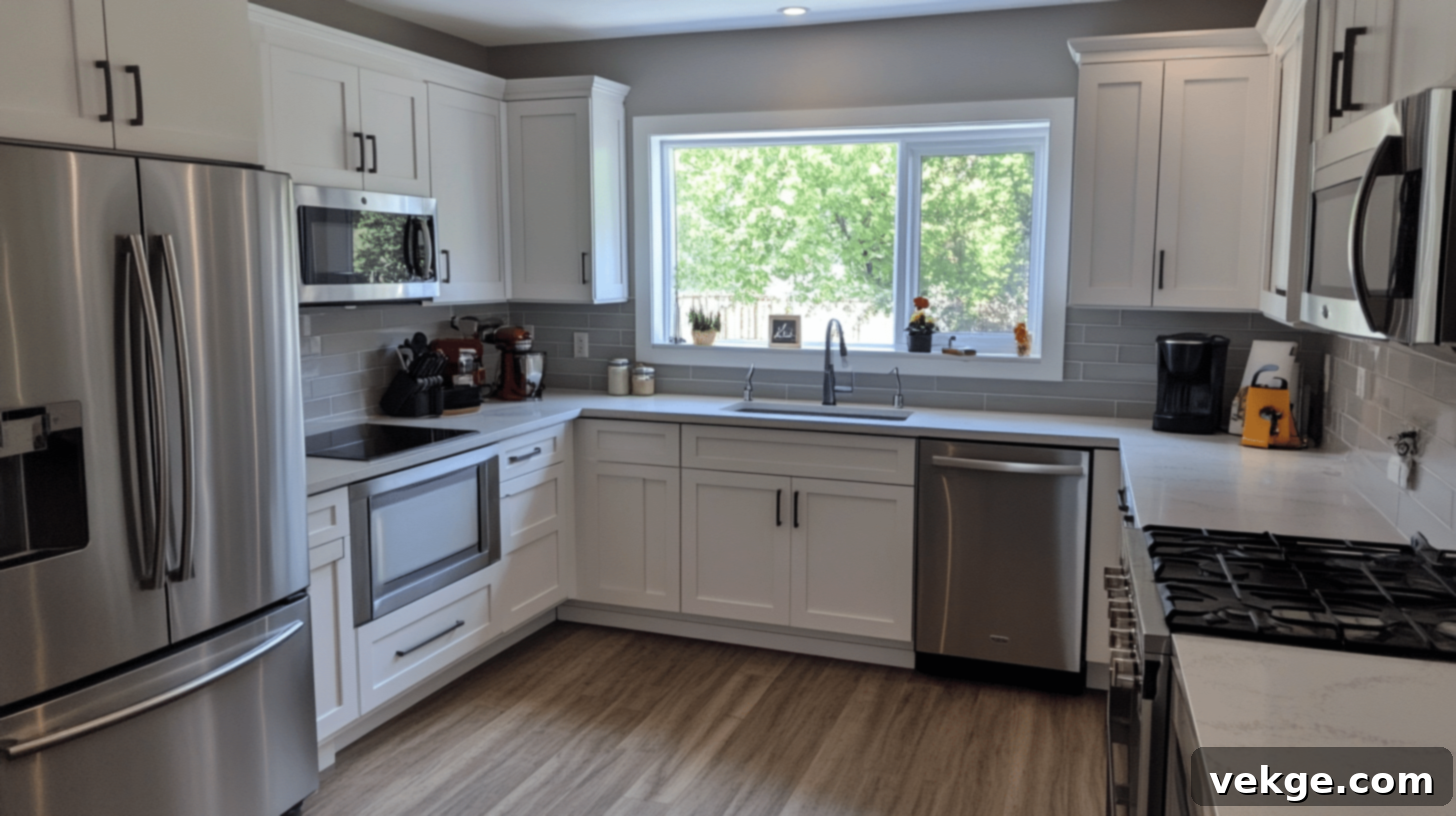
Description: Light grays are versatile and subtle, offering modern sophistication with high light reflectance values. They often carry slight undertones (blue, green, or beige) that add depth and complexity, preventing the room from feeling stark.
My Top Recommendation: Sherwin Williams Repose Gray (SW 7015).
Why It Brightens a Room: Repose Gray is a beautifully balanced light gray with warm undertones that prevent it from feeling cold. It adds depth and a contemporary elegance to a room while maintaining excellent light reflection, keeping the space bright, airy, and neutral enough to complement various decor styles.
Best Uses: Ideal for living rooms, kitchens, home offices, and bedrooms where you want a balanced, polished, and contemporary look. It works particularly well in rooms that receive a mix of natural light throughout the day.
Pastels
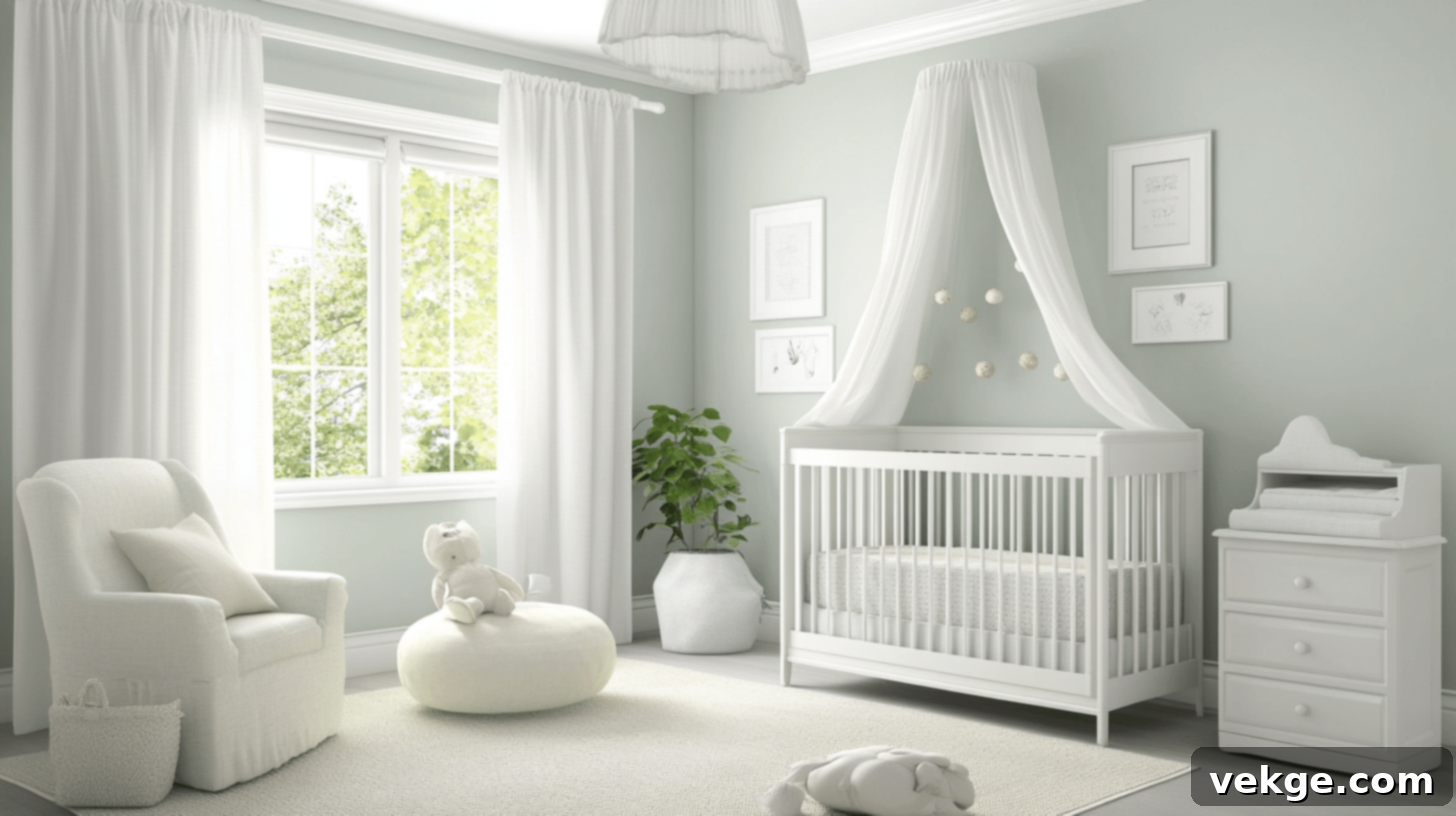
Description: Pastels are soft, muted versions of classic colors like blue, green, pink, and yellow. They offer a gentle infusion of color that can completely transform a room’s mood without overwhelming the space or compromising brightness.
My Top Recommendation: Pale blue (e.g., Benjamin Moore Palladian Blue), mint green (e.g., Sherwin Williams Sea Salt), blush pink (e.g., Farrow & Ball Pink Ground), lemon chiffon (e.g., Sherwin Williams Creamy).
Why It Brightens a Room: Pastels add a subtle, cheerful pop of color while still reflecting plenty of light due to their high white content. They infuse personality and softness, creating a light-hearted and optimistic atmosphere that feels both vibrant and expansive.
Best Uses: Perfect for bedrooms, bathrooms, nurseries, children’s rooms, or any space that benefits from a soft, cheerful, and light vibe. They can make small spaces feel delightful and open.
Soft Yellows
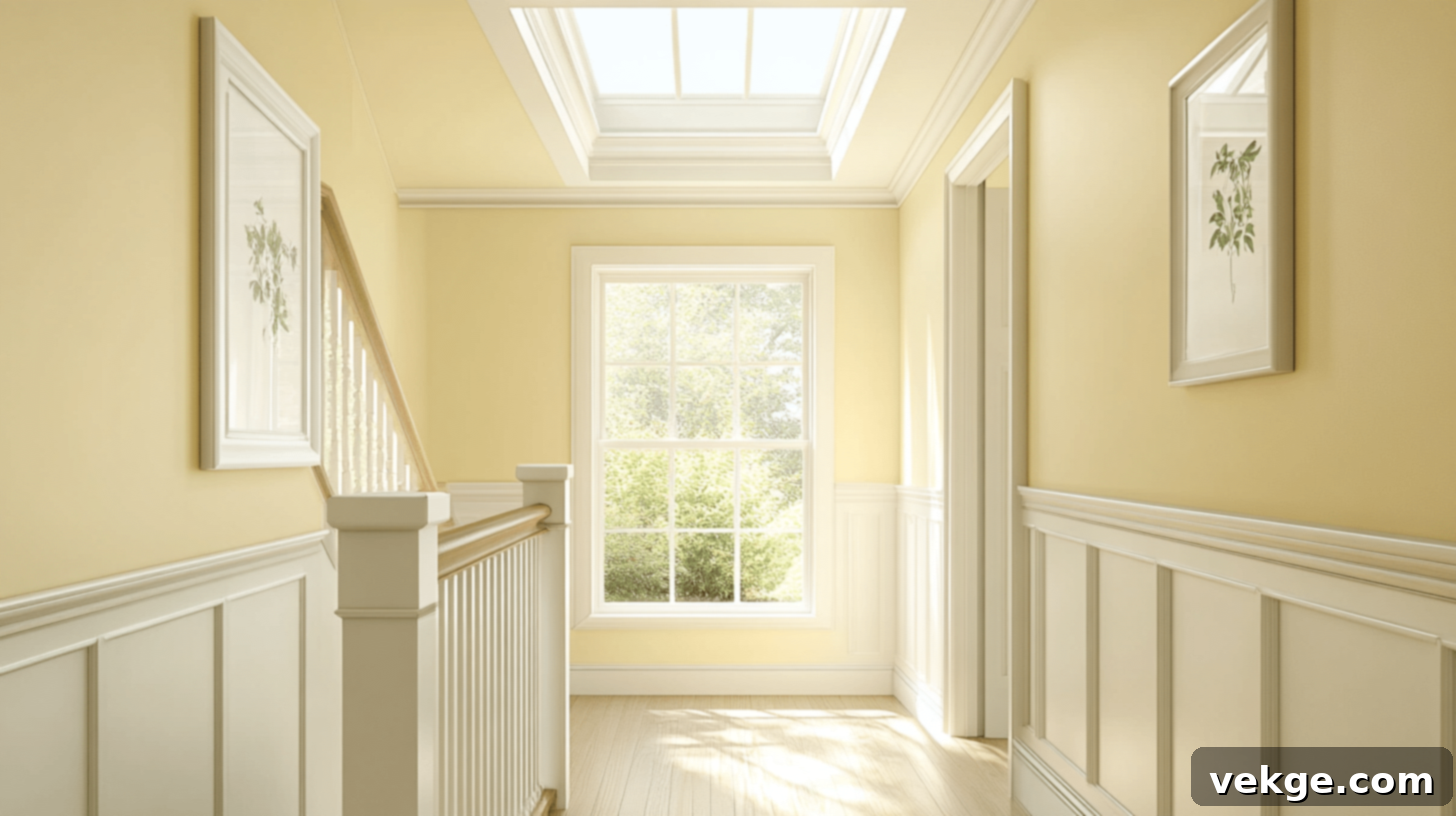
Description: Gentle, sunny hues of yellow mimic the warmth and radiance of natural sunlight. These colors create an instantly uplifting and energetic atmosphere, bringing a perpetual glow to any room, even on cloudy days.
My Top Recommendation: Sherwin Williams Lemon Twist (SW 6909).
Why It Brightens a Room: Lemon Twist is a soft, inviting yellow that perfectly emulates the warmth of sunlight. It instantly brightens a room by infusing it with a cheerful and positive energy, making the space feel more alive, welcoming, and inherently sunny. It’s like having sunshine on your walls year-round.
Best Uses: Excellent for kitchens, hallways, breakfast nooks, and small rooms that need an energetic and welcoming boost. It’s also fantastic for rooms with limited natural light, as it can mimic the sun’s presence.
Cool Blues
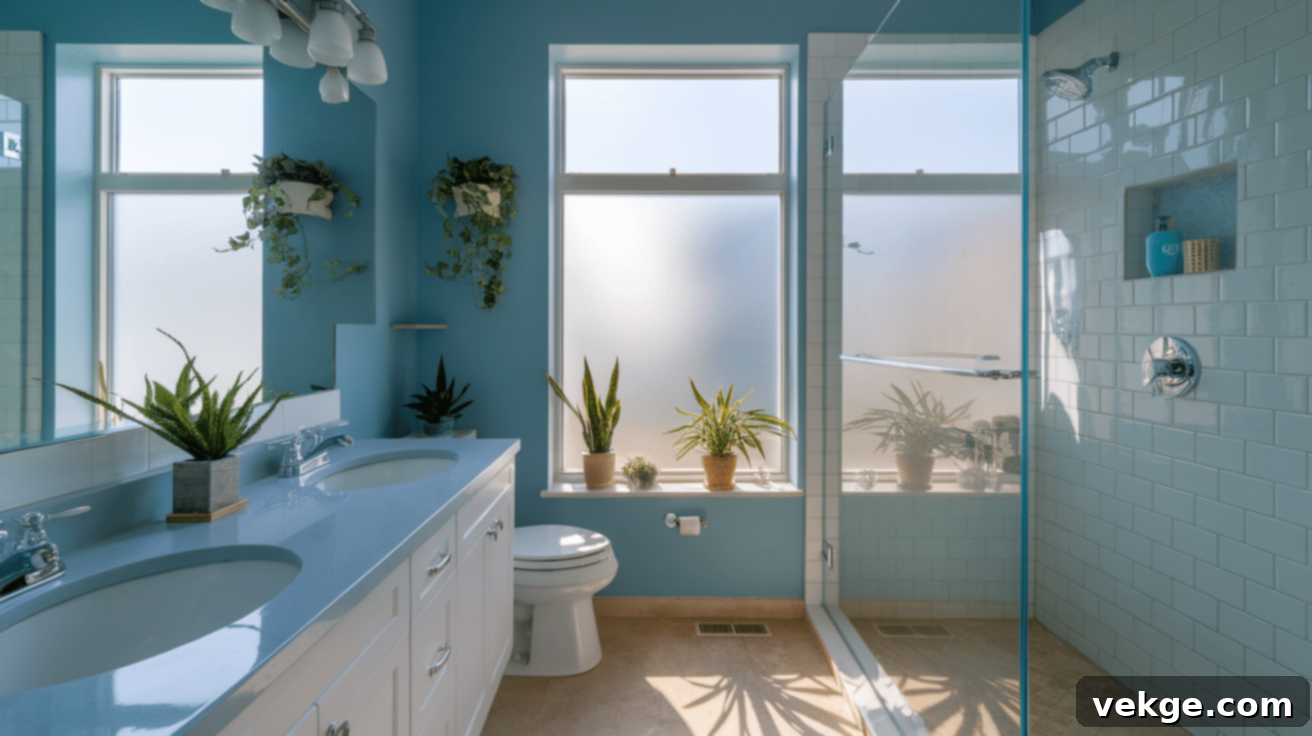
Description: Light, airy blues offer a serene and refreshing feel, much like a clear sky or calm water. Their inherently cool tones and high light reflectance contribute to a tranquil yet open and bright environment.
My Top Recommendation: Sherwin Williams Iceberg (SW 6798).
Why It Brightens a Room: Iceberg is a crisp, clean light blue that effectively enhances natural lighting. It creates a tranquil and serene vibe, making rooms feel incredibly fresh, spacious, and calming. The cool undertones visually expand the space, contributing to a sense of openness.
Best Uses: Perfect for bathrooms, bedrooms, and living rooms where you desire a fresh, relaxing, and airy ambiance. It pairs beautifully with white trim and natural textures, creating a coastal or spa-like feel.
Pale Greens
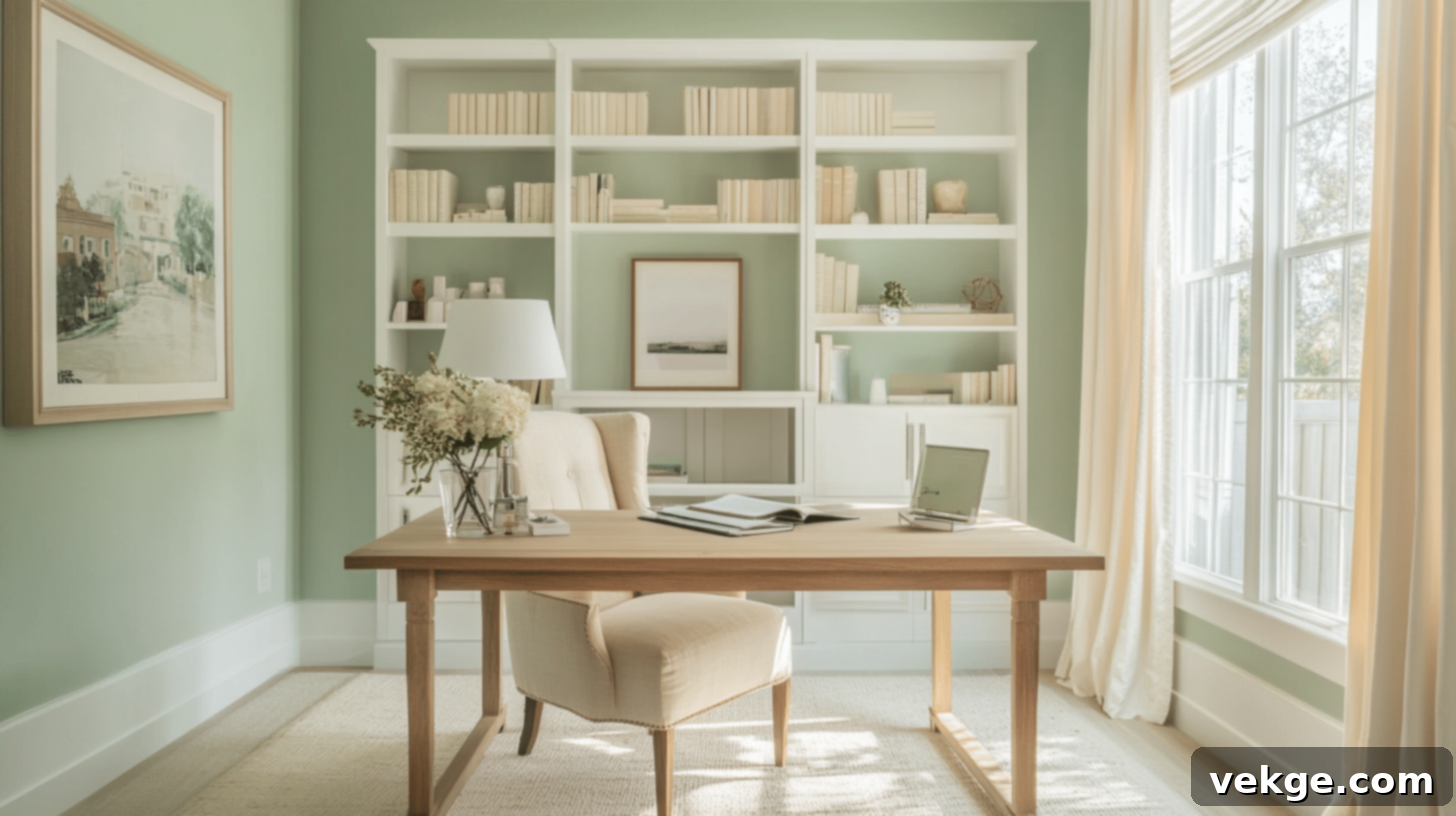
Description: Soft, nature-inspired greens evoke a sense of calm, renewal, and freshness. These gentle hues bring the outdoors in, creating an uplifting and harmonious atmosphere that feels inherently bright and natural.
My Top Recommendation: Sherwin Williams Sea Salt (SW 6204).
Why It Brightens a Room: Sea Salt is a chameleon color that shifts between a light green, blue, and gray depending on the light. Its muted, earthy quality reflects light beautifully while creating a subtle, soothing connection to nature. It makes a room feel instantly fresh, calm, and subtly illuminated.
Best Uses: Excellent for living rooms, kitchens, bathrooms, and bedrooms where you seek a serene, earthy aesthetic and a touch of organic brightness. It’s particularly lovely in spaces where you want to foster a sense of relaxation and well-being.
From the crisp purity of whites to the inviting glow of soft yellows and the serene harmony of pale greens, each of these color families offers unique opportunities to significantly enhance the light and mood in your space. Experiment with samples to see how these transformative colors interact with your unique lighting conditions.
Best Paint Brands for Creating Bright, Airy Spaces
When your goal is to brighten a room, the quality of the paint itself is just as important as the color you choose. High-quality paints from reputable brands offer superior coverage, better light reflection, and long-lasting durability, ensuring your bright new look endures. Investing in premium paint means fewer coats, a smoother finish, and more vibrant, light-enhancing colors. Here are ten top paint brands renowned for their exceptional products that can truly enhance the luminosity of your space:
1. Benjamin Moore Regal Select Interior Paint
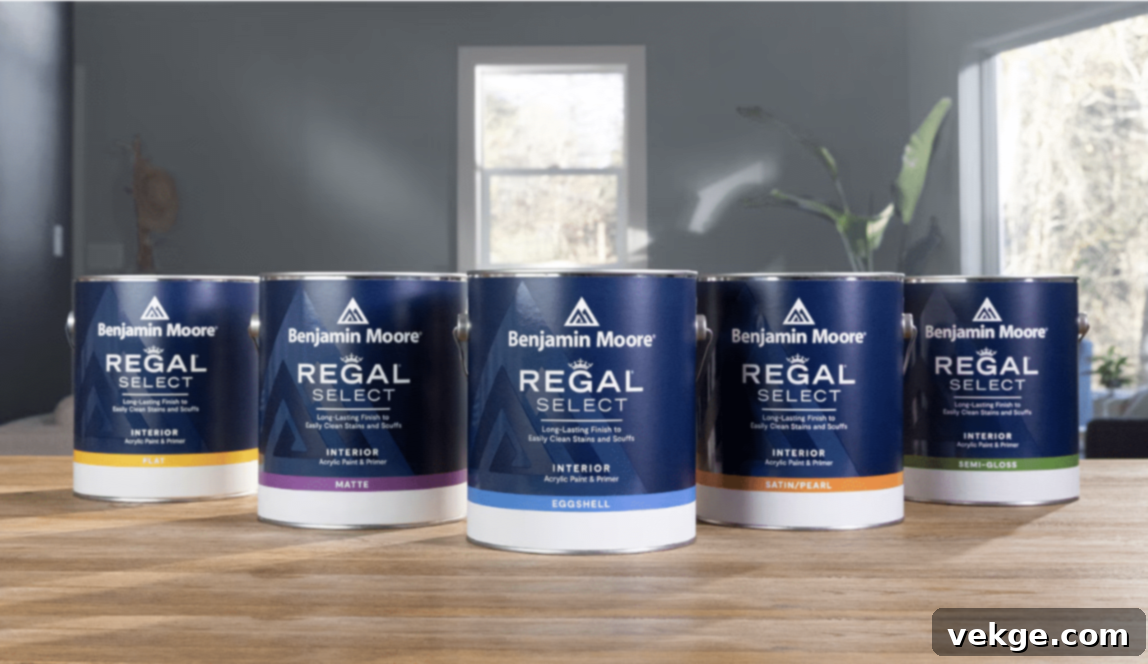
Benjamin Moore Regal Select Interior Paint is a premium choice known for its excellent coverage, smooth application, and remarkable durability. It’s specifically formulated to be washable and stain-resistant, making it an ideal option for high-traffic areas where brightness is paramount but so is practicality. Its high-quality pigments ensure true color depiction, which is essential for light-enhancing shades.
- Type of Paint: Acrylic latex
- Finish: Available in Matte, Eggshell, Pearl (Satin), and Semi-Gloss
- Best Colors in the Range for Brightness: Simply White (OC-117), Chantilly Lace (OC-65), and White Dove (OC-17). These are consistently top picks for their clean, crisp, and reflective qualities.
2. Sherwin-Williams SuperPaint Interior Acrylic Latex
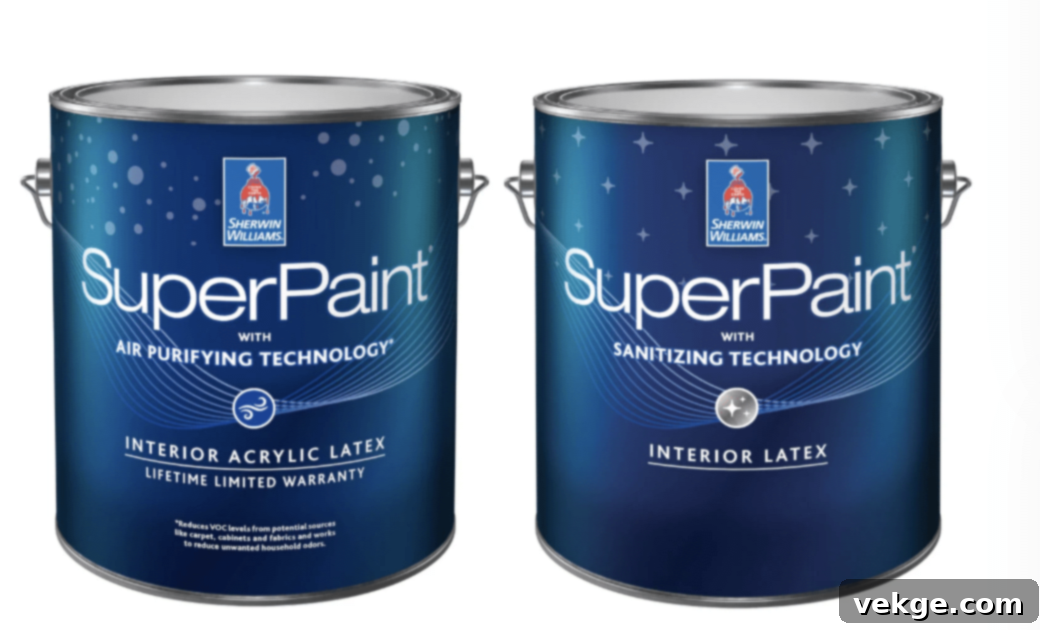
Sherwin-Williams SuperPaint Interior Acrylic Latex is a favorite among homeowners and professionals for its “paint and primer in one” formula, offering exceptional coverage and durability in fewer coats. It’s designed to resist stains and stand up to rigorous scrubbing, making it perfect for active households that need both brightness and resilience. Its consistent finish helps light reflect evenly.
- Type of Paint: Acrylic latex
- Finish: Available in Flat, Satin, and Semi-Gloss
- Best Colors in the Range for Brightness: Alabaster (SW 7008), Pure White (SW 7005), and Snowbound (SW 7004). These shades offer varying degrees of warmth within the white family, all excellent for reflecting light.
3. Farrow & Ball Estate Emulsion
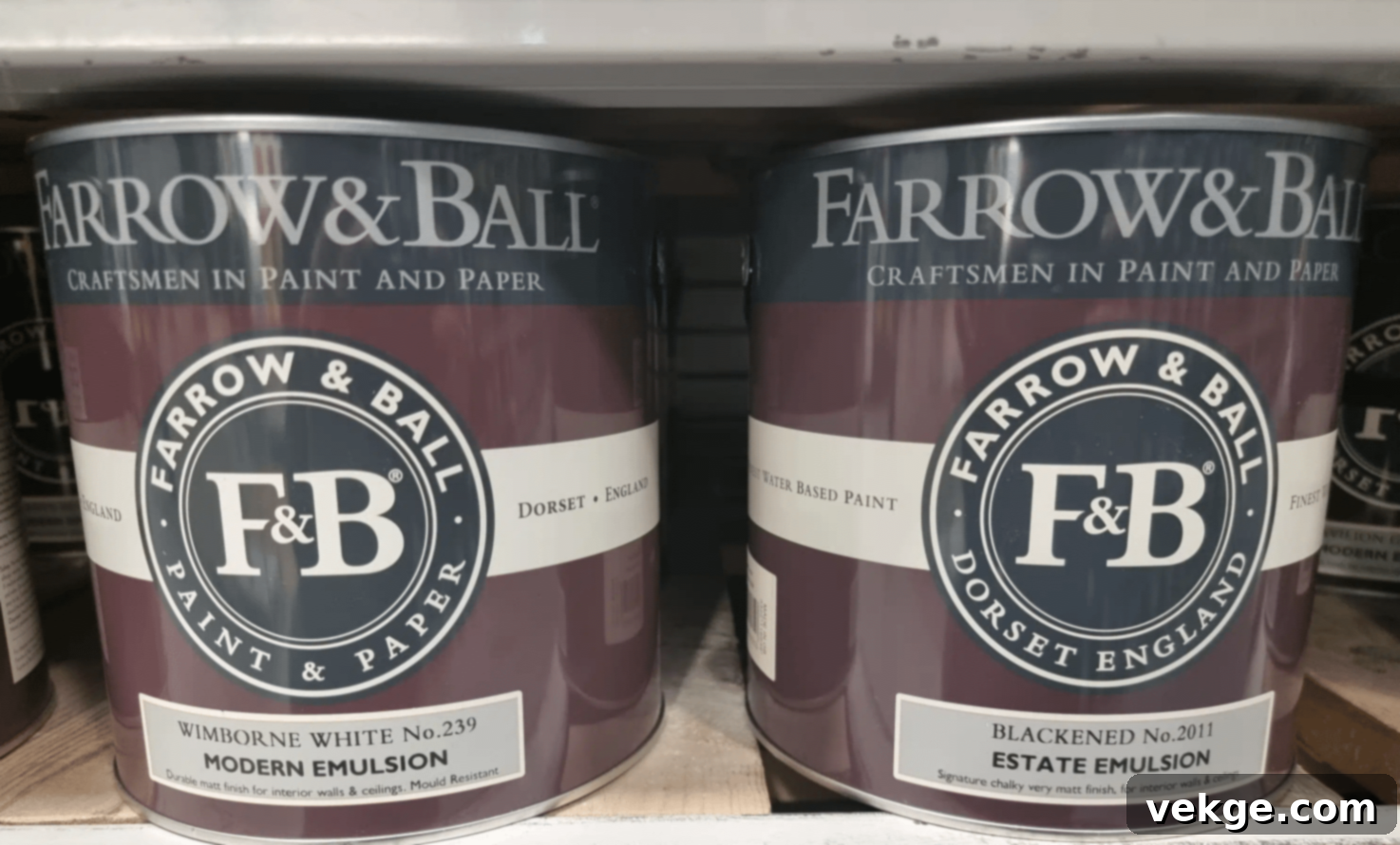
Farrow & Ball Estate Emulsion is renowned for its signature chalky, ultra-matte finish that provides a rich depth of color. While matte finishes generally absorb light, Farrow & Ball’s unique formulation means their lighter shades, particularly whites, still possess a subtle luminosity. Its eco-friendly, water-based formulation is also a plus for those seeking sustainable options.
- Type of Paint: Water-based
- Finish: Matte (2% sheen), offering a soft, powdery look.
- Best Colors in the Range for Brightness: Wimborne White (No. 239), All White (No. 2005), and Pointing (No. 2003). These whites are celebrated for their ability to soften and subtly brighten, creating a sophisticated backdrop.
4. Behr Premium Plus Ultra Interior Paint
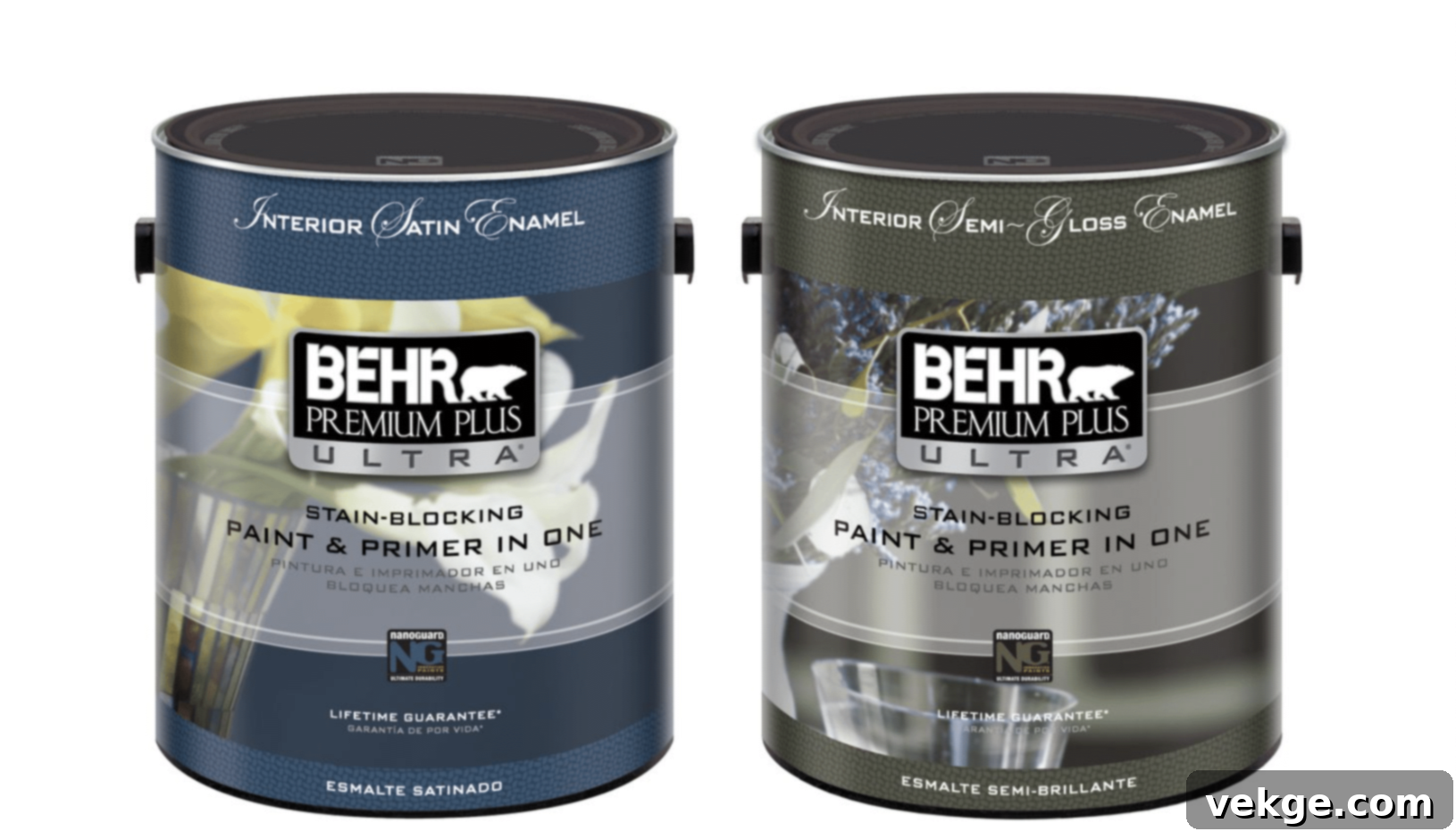
Behr Premium Plus Ultra Interior Paint offers excellent value without compromising on performance, especially for brightening. Its paint and primer combination provides great coverage and a durable, long-lasting finish, making it a solid choice for various interior spaces. Behr’s brighter whites and light neutrals are formulated to maximize light reflection.
- Type of Paint: Acrylic latex
- Finish: Available in Eggshell, Satin, and Semi-Gloss
- Best Colors in the Range for Brightness: Ultra Pure White (PR-W15), Swiss Coffee (12), and Bit of Sugar (PR-W14). These shades are consistently rated highly for their ability to open up and brighten rooms effectively.
5. Valspar Signature Interior Paint + Primer
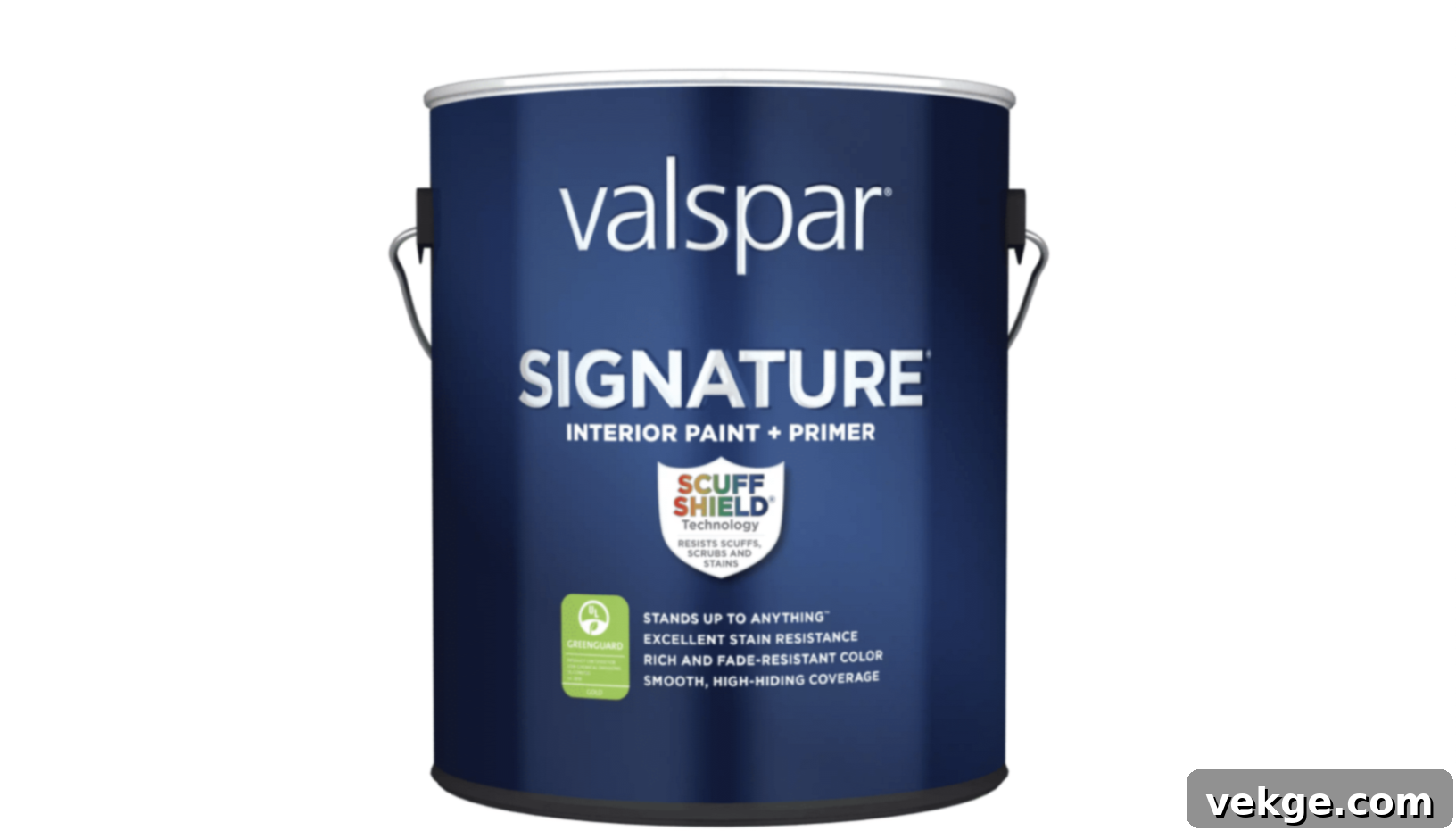
Valspar Signature Interior Paint + Primer is formulated with advanced ScuffShield™ technology, providing enhanced durability and stain resistance. This makes it a smart choice for busy households or high-traffic areas where light colors might otherwise show wear. Its smooth finish contributes to an even reflection of light, making your chosen bright shades truly pop.
- Type of Paint: Acrylic latex
- Finish: Available in Flat, Eggshell, Satin, and Semi-Gloss
- Best Colors in the Range for Brightness: Cream Delight (7002-1), Du Jour (7002-7), and Dove White (7002-3). These are beautiful, luminous whites and off-whites that offer a fresh and airy feel.
6. Dulux EasyCare Washable & Tough

Dulux EasyCare Washable & Tough paint is a powerhouse for families, specifically engineered to resist everyday stains and be 20 times tougher than standard emulsion. This resilience makes it perfect for maintaining the pristine look of light colors in homes with children or pets, ensuring your bright walls stay bright. Its smooth finish ensures good light diffusion.
- Type of Paint: Acrylic latex
- Finish: Available in Matt and Soft Sheen (Satin equivalent)
- Best Colors in the Range for Brightness: Jasmine White, Timeless, and White Cotton. These are popular choices in the UK for creating bright and clean spaces.
7. Glidden Premium Interior Paint

Glidden Premium Interior Paint offers reliable coverage and a smooth finish at a budget-friendly price point, making it an excellent choice for renters or those looking for an affordable home refresh without sacrificing brightness. Its light colors are designed to deliver a fresh, clean look that can significantly open up a room. It’s a great option for achieving a bright aesthetic economically.
- Type of Paint: Acrylic latex
- Finish: Available in Flat, Eggshell, Satin, and Semi-Gloss
- Best Colors in the Range for Brightness: White On White (GLW01), Bright White (GLW03), and Natural White (GLW02). These straightforward whites are formulated to maximize light and space.
8. Benjamin Moore Aura Interior Paint
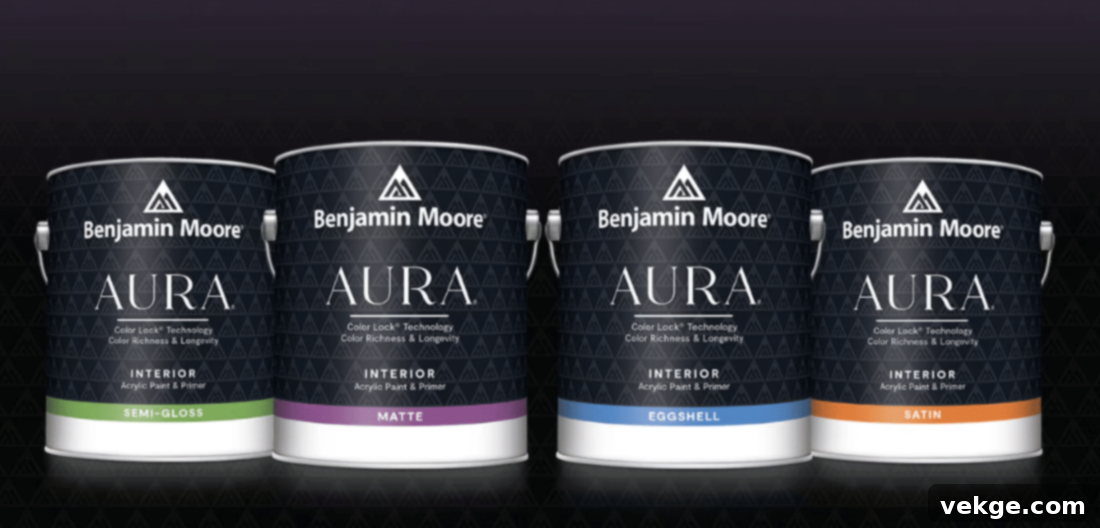
Benjamin Moore Aura Interior Paint is a top-tier paint renowned for its exceptional performance, especially with its proprietary Color Lock® technology. This technology ensures superior coverage and unparalleled fade resistance, making it ideal for maintaining the integrity and brightness of both bold and light shades. It offers a rich, uniform finish that promotes excellent light reflection.
- Type of Paint: Acrylic latex
- Finish: Available in Matte, Eggshell, Satin, and Semi-Gloss
- Best Colors in the Range for Brightness: Super White (OC-152), Chantilly Lace (OC-65), and Decorator’s White (OC-149). These are some of the purest, most reflective whites available, perfect for maximizing light.
9. Sherwin-Williams Emerald Interior Acrylic Latex
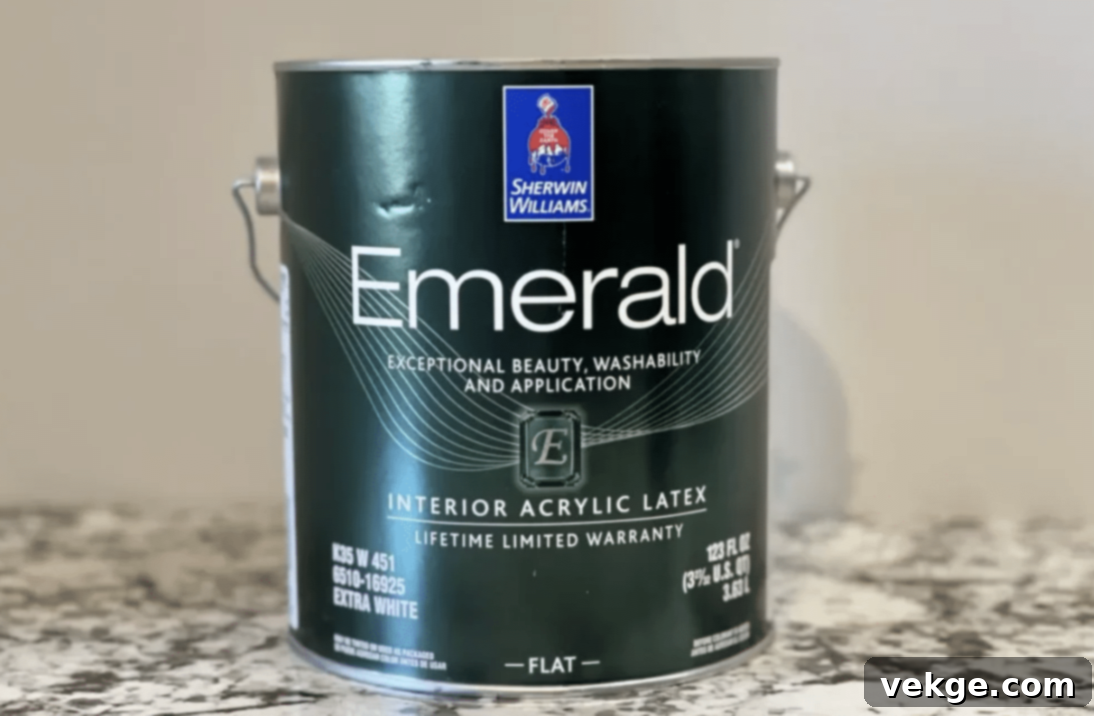
Sherwin-Williams Emerald Interior Acrylic Latex is considered their finest paint, offering exceptional washability and a smooth, luxurious finish. It’s a premium, durable paint option that stands up to heavy use while maintaining its aesthetic appeal. Its advanced formula ensures that light colors appear vibrant and reflective, contributing significantly to a brighter space.
- Type of Paint: Acrylic latex
- Finish: Available in Flat, Satin, and Semi-Gloss
- Best Colors in the Range for Brightness: Extra White (SW 7006), Greek Villa (SW 7551), and Alabaster (SW 7008). These provide excellent brightness with varying undertones to suit different lighting.
10. Farrow & Ball Modern Emulsion

Farrow & Ball Modern Emulsion is a highly durable, washable, water-based paint designed for modern living. While it has a soft sheen (7%), it offers excellent durability, making it suitable for busy areas like kitchens and hallways. Its carefully crafted colors, even the lighter ones, possess a unique depth that can make a room feel both elegant and subtly brightened.
- Type of Paint: Water-based
- Finish: Modern Emulsion (7% sheen), a low-sheen satin.
- Best Colors in the Range for Brightness: Wevet (No. 273), Ammonite (No. 274), and School House White (No. 291). These offer sophisticated, subtle brightness with a touch of nuanced character.
By choosing one of these high-quality brands and their recommended bright colors, you’re setting yourself up for success in creating truly luminous and inviting living spaces.
Enhancing Brightness with Painting Techniques
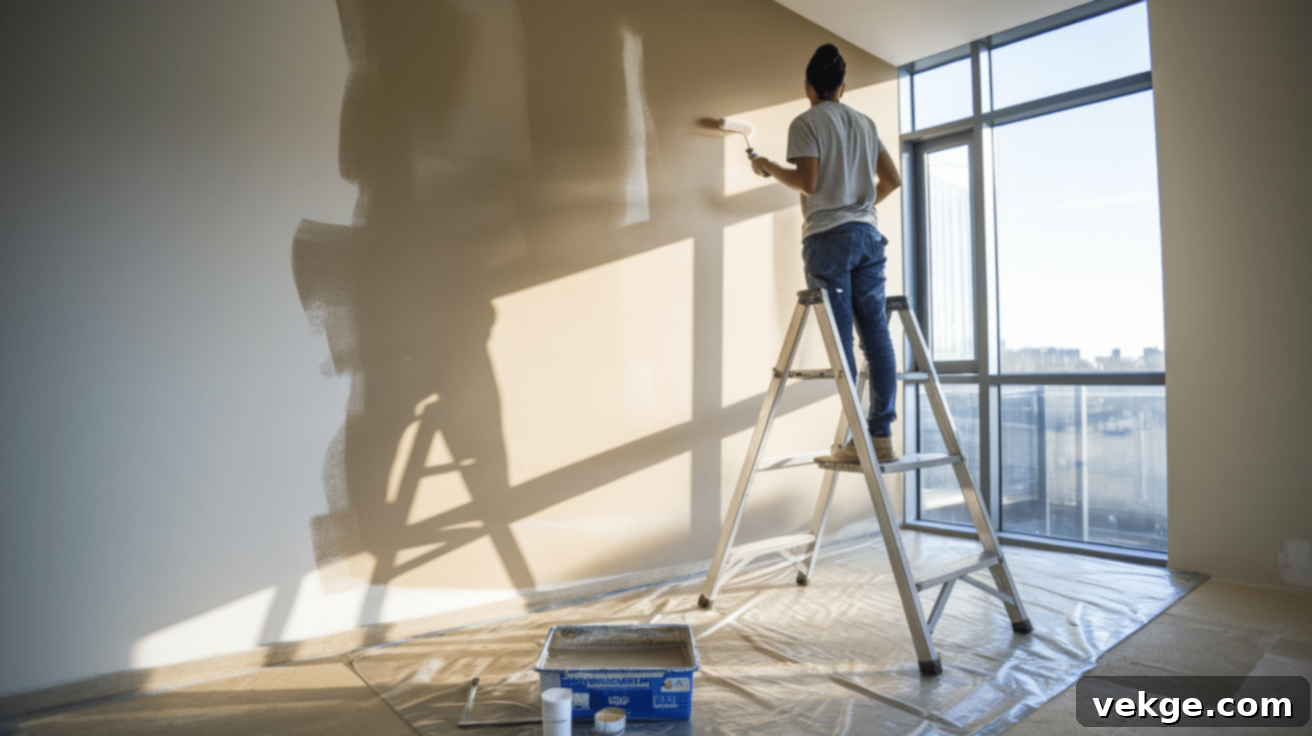
Beyond selecting the right colors and finishes, clever painting techniques can dramatically impact a room’s perceived brightness and spaciousness. During my 15 years as a professional painter, I’ve developed and refined unique methods to make even the darkest rooms feel alive with light. These aren’t just tricks; they’re tested techniques that leverage visual perception to transform your space.
Paint Direction for Height (Ceiling Tricks)
I first discovered this technique when working on a challenging basement renovation project. The low ceilings made the space feel incredibly cramped until I tried this simple yet effective method, making the entire room feel instantly taller and more open.
- Makes ceilings appear higher: Paint your ceiling in a color lighter than your walls, typically a crisp white. This creates an optical illusion where the ceiling visually lifts, giving the impression of greater vertical space.
- Creates visual interest without overwhelming: Instead of stark white, consider a very pale, cool-toned white for the ceiling. This adds subtle character without drawing attention away from the walls or making the space feel busy.
- Opens up cramped spaces: This technique is particularly impactful in small rooms or areas with naturally low ceilings, instantly making them feel less enclosed and more expansive.
- Works especially well in narrow hallways: In long, narrow spaces, a lighter ceiling helps to broaden the perception of width, mitigating the tunnel effect.
- Ideal for rooms under 8 feet tall: If your room height is standard or lower, this technique becomes even more vital for creating an airy feel.
Light-Enhancing Borders (White Trim & Baseboards)
I learned this trick while helping a client with a north-facing room that desperately needed more light. The change after applying this technique was so striking that it’s now an essential part of my standard brightening toolkit.
- Pulls in more natural light: Painting window frames, trim, and baseboards in a bright, crisp white helps frame natural light sources. These white borders reflect light back into the room, enhancing the overall illumination.
- Spreads brightness throughout the room: The reflective quality of white trim acts like mini-mirrors, bouncing light around the perimeter of the room and into darker corners.
- Makes windows appear larger: A bright white frame around a window draws the eye and makes the window opening seem more substantial, maximizing the perceived size of your light source.
- Brightens doorways naturally: Similarly, white door frames and doors contribute to a sense of openness and guide light through the room, making transitions feel lighter.
- Adds subtle shine without glare: Using a semi-gloss or satin finish on trim provides a subtle sheen that reflects light without creating harsh glare, adding to the room’s polished feel.
Corner Brightening Tips (Gradient Painting)
After years of painting countless dark rooms, I frequently noticed how corners absorbed and trapped light. Implementing this simple adjustment made a remarkable difference in the overall perception and brightness of the room.
- Makes rooms feel wider: Consider painting the corners of a room a slightly lighter shade than the main walls, or even a very soft white, blending inwards subtly. This creates a visual gradient that makes the walls appear to recede and expands the perceived width of the room.
- Reduces shadowy areas: Corners are notorious for accumulating shadows. Lightening them helps to diminish these dark spots, creating a more uniform and luminous environment.
- Creates better light flow: By brightening the corners, you encourage light to flow more freely around the room, reducing visual barriers and making the space feel more cohesive.
- Improves room proportions: This technique can soften harsh angles and make a room feel less boxy, improving its overall balance and visual appeal.
- Makes furniture placement easier: When corners are less dark and imposing, the room feels more open, offering greater flexibility in arranging furniture without feeling cramped.
Two-Tone Wall Method (Horizontal Division)
This technique emerged from a challenging dining room project where the client desired significant brightness but was unwilling to sacrifice a sense of warmth and character. This innovative two-tone solution delivered both beautifully.
- Adds visual interest and character: By dividing the wall horizontally, typically with a lighter color on the top two-thirds and a slightly darker (but still light) color on the bottom, you create a dynamic look.
- Creates balanced lighting: The lighter color on the upper portion of the wall maximizes light reflection where it matters most, closer to the ceiling and natural light sources, while the bottom color grounds the space.
- Makes rooms feel larger: A lighter color on the upper part of the wall, especially if extended to the ceiling, draws the eye upward, making the room feel taller. The horizontal line can also create a sense of expansive width.
- Maintains a cozy atmosphere: The slightly darker bottom portion can introduce a subtle depth or warmth, preventing the room from feeling too stark or cold, while the top ensures brightness.
- Hides wear and tear at the base level: The darker bottom color is more forgiving for scuffs and marks, making this a practical choice for high-traffic areas without compromising the room’s overall brightness.
Shadow Management (Strategic Wall Painting)
I developed this method after repeatedly noticing how dominant shadows severely impacted overall room brightness, particularly in spaces with limited or directional natural light. It’s now my go-to solution for achieving consistent brightness.
- Balances overall room lighting: Identify the walls that receive the most natural light and the walls that are perpetually in shadow. Paint the shadow-prone walls a slightly lighter or more reflective version of your chosen color, or even a pure white, to compensate for the lack of natural light.
- Reduces dark spots: By intentionally lightening walls that consistently receive less light, you effectively diminish prominent dark spots and create a more uniform light distribution throughout the room.
- Makes rooms feel more open: Eliminating deep shadows helps the room feel less enclosed and more expansive, as there are fewer visual barriers created by stark darkness.
- Improves artificial lighting effectiveness: Lighter walls mean that artificial lights will also be more effective, as their light will be reflected rather than absorbed, amplifying their impact.
- Creates consistent brightness levels: This technique ensures that even if one side of your room faces north, it won’t feel disproportionately darker than a south-facing wall, leading to a balanced and consistently bright environment.
By integrating these expert painting techniques with your carefully chosen light-enhancing colors, you can achieve a level of brightness and spaciousness that goes beyond what paint color alone can deliver. These methods are particularly effective for rooms that present unique lighting challenges.
Paint Mistakes to Avoid
Even with the best intentions, it’s easy to fall into common traps when choosing paint colors, especially when aiming for a brighter space. Having painted hundreds of rooms, I’ve observed these recurring errors time and again. Skipping these simple mistakes will save you time, money, and frustration, ensuring your space truly feels bright and open, just as you envisioned.
The Most Common Paint Mistakes to Steer Clear Of:
- Picking paint colors based only on store displays or phone screens: The lighting in a paint store or the backlighting of a screen can drastically alter a color’s appearance. What looks perfect there might look completely different in your home’s unique lighting conditions. Always test in your actual space.
- Not checking how the paint looks during different times of day: A color can look vibrant in morning sun, muted in afternoon shade, and warm under evening artificial lights. Failing to observe this can lead to a color you love at one time of day but dislike at another.
- Using too many dark colors in a room with limited natural light: Dark colors absorb light, making already dim rooms feel even smaller and gloomier. While accent walls can work, extensive use of dark hues will counteract any brightening efforts.
- Putting glossy paint on walls with surface flaws or bumps: High-sheen finishes like semi-gloss or high-gloss are highly reflective. This means they will mercilessly highlight every imperfection, dent, or uneven patch on your walls. Stick to eggshell or satin for less-than-perfect surfaces.
- Painting all walls the same dark color in a small, dark room: While sometimes a bold, dark statement can work in large, well-lit rooms, doing this in a small, dark space will create a cavelike, claustrophobic atmosphere. Varying shades or using lighter colors is key.
- Forgetting to clean walls before painting, which dulls the finish: Dirt, dust, and grime can prevent paint from adhering properly, leading to an uneven finish that absorbs light rather than reflecting it. Always clean your walls thoroughly before applying primer or paint.
- Not using primer, leading to uneven light reflection: Primer provides a uniform base for your paint, ensuring true color rendition and consistent light reflection. Skipping it can result in patchy coverage and duller spots where the light isn’t bouncing effectively.
- Mixing warm and cool tones without planning: While intentional contrast can be beautiful, haphazardly mixing warm (yellow, red) and cool (blue, green) undertones in adjacent elements can create a jarring, unbalanced feel that detracts from brightness.
- Using flat paint in rooms that need light reflection: Flat (matte) paint absorbs light, which is great for hiding imperfections or creating a cozy, sophisticated look in well-lit areas. However, for rooms you want to brighten, it’s counterproductive as it won’t bounce light around.
- Choosing trendy dark colors without thinking about brightness: Current trends might feature deep, moody hues. While stylish, these colors are not always practical for brightening. Always prioritize your room’s natural light and functional needs over fleeting trends.
These common paint mistakes are surprisingly easy to make, but thankfully, they’re even simpler to avoid with a little forethought and careful planning. By being mindful of these pitfalls, you can ensure your paint project is a resounding success, culminating in a space that feels beautifully bright and open.
Wrapping It Up
Transforming your rooms from dim to dazzling doesn’t have to be a daunting task. By applying the insights from this guide, you’re now equipped with the knowledge and confidence to make informed paint choices that will significantly enhance your home’s brightness and appeal. We’ve explored the fundamental principles of color theory, the critical considerations for your specific space, the best paint finishes for light reflection, and top-performing color families and brands.
Remember these essential keys to success:
- Embrace Light Colors: They are your most powerful tool for reflecting light and expanding space.
- Prioritize Proper Testing: Always test samples in your actual room, observing them throughout the day.
- Don’t Skip Preparation: Clean walls and primer are crucial for a smooth, reflective finish.
- Leverage Painting Techniques: Strategic application can amplify the brightening effect.
Start with a small room, grab a few test samples of colors that caught your eye, and watch how the light plays with them throughout the day. Pay attention to how different undertones emerge and how the overall mood of the room shifts. This hands-on experience is invaluable. Your journey to a brighter, more inviting home is just a paint job away!
Ready to get started? Pick your first room, consult your paint samples, and begin the exciting process of bringing more light into your life. The refreshed, luminous space you desire is well within reach!
